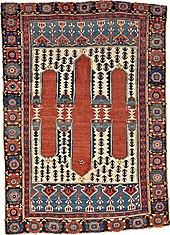 Global Information
Global InformationAnatolian rug information


Anatolian rug is a term of convenience, commonly used today to denote rugs and carpets woven in Anatolia and its adjacent regions. Geographically, its area of production can be compared to the territories which were historically dominated by the Ottoman Empire. It denotes a knotted, pile-woven floor or wall covering which is produced for home use, local sale, and export, and religious purpose. Together with the flat-woven kilim, Anatolian rugs represent an essential part of the regional culture, which is officially understood as the Culture of Turkey today, and derives from the ethnic, religious and cultural pluralism of one of the most ancient centres of human civilisation.
Rug weaving represents a traditional craft dating back to prehistoric times. Rugs were woven much earlier than even the oldest surviving rugs like the Pazyryk rug would suggest. During its long history, the art and craft of the woven carpet has absorbed and integrated different cultural traditions. Traces of Byzantine design can be observed in Anatolian rugs; Turkic peoples migrating from Central Asia, as well as Armenian people, Caucasian and Kurdic tribes either living in, or migrating to Anatolia at different times in history contributed their traditional motifs and ornaments. The arrival of Islam and the development of the Islamic art has profoundly influenced the Anatolian rug design. Its ornaments and patterns thus reflect the political history and social diversity of the area. Since rug export was so popular within Iran, the cultural motives and display on the Anatolian rugs vary.
Within the group of oriental carpets, the Anatolian rug is distinguished by particular characteristics of its dyes and colours, motifs, textures and techniques. Examples range in size from small pillows (yastik) to large, room-sized carpets. The earliest surviving examples of Anatolian rugs known today date from the thirteenth century. Distinct types of rugs have been woven ever since in court manufactures and provincial workshops, village homes, tribal settlements, or in the nomad's tent. Rugs were simultaneously produced at all different levels of society, mainly using sheep wool, cotton and natural dyes. Anatolian rugs are most often tied with symmetrical knots, which were so widely used in the area that Western rug dealers in the early 20th century adopted the term "Turkish" or "Ghiordes" knot for the technique. From the 1870s onwards, the Ottoman court manufactures also produced silk-piled rugs, sometimes with inwoven threads of gold or silver, but the traditional material of the majority of Anatolian rugs was hand-spun, naturally-dyed wool.
In Europe, Anatolian rugs were frequently depicted in Renaissance paintings, often in a context of dignity, prestige and luxury. Political contacts and trade intensified between Western Europe and the Islamic world after the 13th century AD. When direct trade was established with the Ottoman Empire during the 14th century, all kinds of carpets were at first indiscriminately given the trade name of "Turkish" carpets, regardless of their actual place of manufacture. Since the late nineteenth century, oriental rugs have been subject to art historic and scientific interest in the Western world. The richness and cultural diversity of rug weaving were gradually better understood. More recently, also flat woven carpets (Kilim, Soumak, Cicim, Zili) have attracted the interest of collectors and scientists.
The art and craft of the Anatolian rug underwent serious changes by the introduction of synthetic dyes from the last third of the 19th century onwards. The mass production of cheap rugs designed for commercial success had brought the ancient tradition close to extinction. In the late twentieth century, projects like the DOBAG Carpet Initiative have successfully revived the tradition of Anatolian rug weaving using hand-spun, naturally-dyed wool and traditional designs
| Part of a series on the |
| Culture of Turkey |
|---|
 |
| Languages |
| Mythology and folklore |
| Cuisine |
| Festivals |
| Religion |
| Art |
| Literature |
|